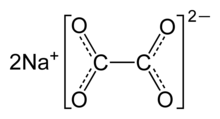Sodium oxalate
Sodium oxalate, or disodium oxalate, is the sodium salt of oxalic acid with the formula Na2C2O4. It is a white, crystalline, odorless solid, that decomposes above 290 °C.[2]
 | |
| Names | |
|---|---|
| IUPAC name
Sodium ethanedioate | |
| Other names
Oxalic acid, disodium salt Sodium ethanedioate | |
| Identifiers | |
3D model (JSmol) |
|
| ChEBI | |
| ChEMBL | |
| ChemSpider | |
| ECHA InfoCard | 100.000.501 |
| EC Number |
|
PubChem CID |
|
| RTECS number |
|
| UNII | |
CompTox Dashboard (EPA) |
|
| |
| |
| Properties | |
| Na2C2O4 | |
| Molar mass | 133.999 g mol−1 |
| Density | 2.34 g cm−3 |
| Melting point | 260 °C (500 °F; 533 K) decomposes above 290 °C[2] |
| 2.69 g/100 mL (0 °C) 3.7 g/100 mL (20 °C) 6.25 g/100 mL (100 °C) | |
| Solubility | soluble in formic acid insoluble in alcohol, ether |
| Structure | |
| monoclinic | |
| Thermochemistry | |
Std enthalpy of formation (ΔfH⦵298) |
-1318 kJ/mol |
| Hazards | |
| Safety data sheet | Oxford MSDS |
EU classification (DSD) (outdated) |
|
| NFPA 704 (fire diamond) | |
| Lethal dose or concentration (LD, LC): | |
LD50 (median dose) |
11160 mg/kg (oral, rat)[1] |
Except where otherwise noted, data are given for materials in their standard state (at 25 °C [77 °F], 100 kPa). | |
| Infobox references | |
Disodium oxalate can act as a reducing agent, and it may be used as a primary standard for standardizing potassium permanganate (KMnO4) solutions.
The mineral form of sodium oxalate is natroxalate. It is only very rarely found and restricted to extremely sodic conditions of ultra-alkaline pegmatites.[3]
Preparation
Sodium oxalate can be prepared through the neutralization of oxalic acid with sodium hydroxide (NaOH) in a 1:2 acid-to-base molar ratio. Evaporation yields the anhydrous oxalate[4] that can be thoroughly dried by heating to between 200 and 250 °C.[2]
Half-neutralization can be accomplished with NaOH in a 1:1 ratio which produces NaHC2O4, monobasic sodium oxalate or sodium hydrogenoxalate.
Alternatively, it can be produced by decomposing sodium formate by heating it at a temperature exceeding 360 °C.
Reactions
Sodium oxalate starts to decompose above 290 °C into sodium carbonate and carbon monoxide:[2]
- Na
2C
2O
4 → Na
2CO
3 + CO
When heated at between 200 and 525°C with vanadium pentoxide in a 1:2 molar ratio, the above reaction is suppressed, yielding instead a sodium vanadium oxibronze with release of carbon dioxide[5]
- x Na
2C
2O
4 + 2 V
2O
5 → 2 Na
xV
2O
5 + 2x CO
2
with x increasing up to 1 as the temperature increases.
Sodium oxalate is used to standardize potassium permanganate solutions. It is desirable that the temperature of the titration mixture is greater than 60 °C to ensure that all the permanganate added reacts quickly. The kinetics of the reaction is complex, and the manganese(II) ions formed catalyze the further reaction between permanganate and oxalic acid (formed in situ by the addition of excess sulfuric acid). The final equation is as follows:[6]
- 5 Na2C2O4 + 2 KMnO4 + 8 H2SO4 → K2SO4 + 5 Na2SO4 + 2 MnSO4 + 10 CO2 + 8 H2O
Biological activity
Like several other oxalates, sodium oxalate is toxic to humans. It can cause burning pain in the mouth, throat and stomach, bloody vomiting, headache, muscle cramps, cramps and convulsions, drop in blood pressure, heart failure, shock, coma, and possible death. Mean lethal dose by ingestion of oxalates is 10-15 grams/kilogram of body weight (per MSDS).
Sodium oxalate, like citrates, can also be used to remove calcium ions (Ca2+) from blood plasma. It also prevents blood from clotting. Note that by removing calcium ions from the blood, sodium oxalate can impair brain function, and deposit calcium oxalate in the kidneys.
References
- "ChemIDplus - 62-76-0 - ZNCPFRVNHGOPAG-UHFFFAOYSA-L - Disodium oxalate - Similar structures search, synonyms, formulas, resource links, and other chemical information". chem.nlm.nih.gov. NIH. Retrieved 7 January 2019.
- Yoshimori T1, Asano Y, Toriumi Y, Shiota T. (1978) "Investigation on the drying and decomposition of sodium oxalate". Talanta, volume 25, issue 10, pages 603-605. doi:10.1016/0039-9140(78)80158-1
- "Natroxolate" (PDF). RRUFF. Mineral Data Publishing. Retrieved 7 January 2019.
- H. W. Foote and John E. Vance (1933), "The system; sodium iodate, sodium oxalate, water". American Journal of Science, series 5, volume 26, issue 151, pages 16-18. doi:10.2475/ajs.s5-26.151.16
- D. Ballivet-Tkatchenko, J. Galy, -M. Savariault (1994): "Thermal decomposition of sodium oxalate in the presence of V2O5: Mechanistic approach of sodium oxibronzes formation". Thermochimica Acta, volume 232, issue 2, pages 215-223. doi:10.1016/0040-6031(94)80061-8
- Mcbride, R. S. (1912). "The standardization of potassium permanganate solution by sodium oxalate". J. Am. Chem. Soc. 34 (4): 393–416. doi:10.1021/ja02205a009.
